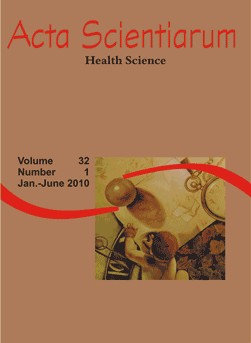<b>Physical exercise dependence and the use of ergogenic resources</b> - DOI: 10.4025/actascihealthsci.v32i1.4475
Keywords:
dependence, exercise, body mass index.Introdução
Abstract
The aim of this study is to investigate the occurrence of physical exercise dependence in regards to the characteristics of participants in weight training and exercises at gyms, such as the use of ergogenic resources, gender and body mass index. Eighty subjects (27.12 ± 6.60 years) from both genders took part in the study, all of whom practiced gymnastics and/or weight training in gyms. The study utilized the Exercise Dependence Scale, a check list of the kinds of nutritional supplementation used as ergogenic resources, and the Body Mass Index – BMI (Kg cm-²). Statistical analysis was performed using Spearman's correlation and the Wilcoxon test (p < 0.05). The results showed that there was no statistically significant difference between physical exercise dependence in men (5.14 ± 1.28) and women (5.60 ± 1.45). The body mass index did not show statistically significant correlation with the scores of dependency, either. However, dependent men showed high prevalence of use of ergogenic resources (63.63%, p = 0.01), while for dependent women there were no statistically significant results. The body mass index does not relate to the scores of exercise dependence. However, even with a normal BMI, the use of ergogenic resources presents high prevalence among dependent men. As a result, there is evidence that physical exercise dependence is a risk factor for the development of emotional disturbances related to exercise, such as muscle dysmorphia and overtraining.Downloads
Download data is not yet available.
Published
2009-12-07
How to Cite
Vieira, J. L. L., Rocha, P. G. M., & Ferrarezi, R. A. (2009). <b>Physical exercise dependence and the use of ergogenic resources</b> - DOI: 10.4025/actascihealthsci.v32i1.4475. Acta Scientiarum. Health Sciences, 32(1), 35-41. https://doi.org/10.4025/actascihealthsci.v32i1.4475
Issue
Section
Physical Education
DECLARATION OF ORIGINALITY AND COPYRIGHTS
I Declare that current article is original and has not been submitted for publication, in part or in whole, to any other national or international journal.
The copyrights belong exclusively to the authors. Published content is licensed under Creative Commons Attribution 4.0 (CC BY 4.0) guidelines, which allows sharing (copy and distribution of the material in any medium or format) and adaptation (remix, transform, and build upon the material) for any purpose, even commercially, under the terms of attribution.
Read this link for further information on how to use CC BY 4.0 properly.























5.png)







